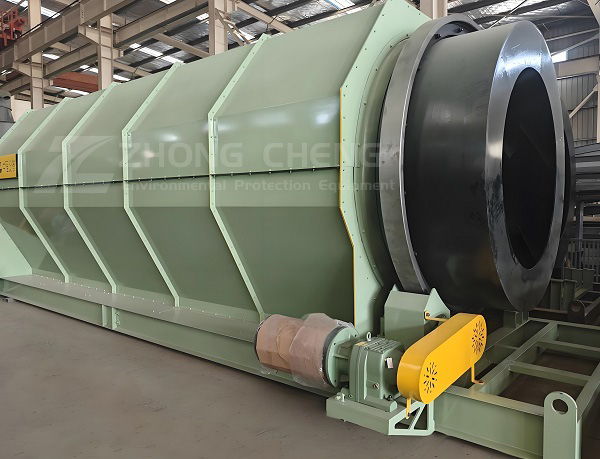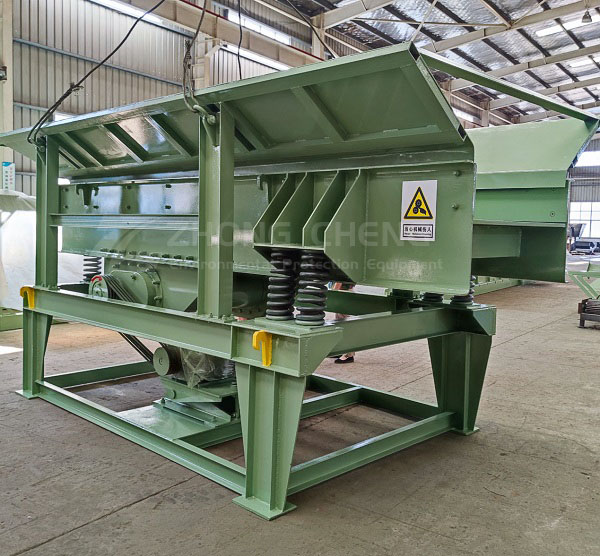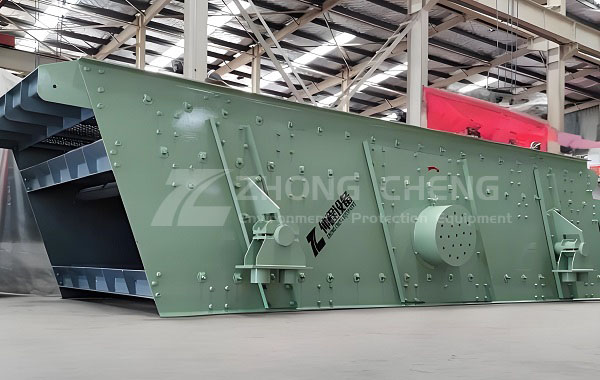Urban garbage screening is crucial in the garbage disposal process. Through screening, recyclables, hazardous waste and other garbage can be effectively separated, resource recycling rate can be improved, and environmental pollution can be reduced. The screened garbage can be treated in a targeted manner according to its nature. Screening can also help reduce the landfill area and extend its service life. Urban garbage screening is an important means to achieve garbage reduction, resource utilization and harmless treatment, and is of great significance for promoting urban sustainable development.
A. Necessity and significance of urban garbage screening

Zhongcheng Machinery's trommel screen
The necessity of urban garbage screening is mainly reflected in the following aspects:
1. Reduce environmental pollution: Urban garbage often contains a large amount of organic matter, which will release harmful gases during a long period of corruption and pollute the atmosphere and soil. Through screening treatment, organic matter can be separated from inorganic matter, reducing the release of harmful gases, thereby reducing environmental pollution. In addition, screening can also treat garbage containing harmful substances separately to prevent it from causing harm to the environment and human health.
2. Improve resource utilization: Urban garbage contains rich recyclable resources, such as metals, plastics, paper, etc. Through screening treatment, these resources can be effectively separated and the resource recycling rate can be improved. These recycled resources can be reprocessed and utilized to reduce the demand for new resources, thereby realizing the recycling of resources.
3. Optimize garbage disposal methods: Screening treatment can adopt different treatment methods according to the different components and properties of garbage. For example, organic matter can be composted or fermented to be converted into organic fertilizer or bioenergy; inorganic matter can be landfilled or brick-made to reduce the waste of land resources. This classification treatment method helps to optimize the garbage disposal process and improve the treatment efficiency.
4. Promote urban sustainable development: Urban garbage screening treatment is an important part of urban sustainable development. Through screening treatment, garbage pollution to the environment can be reduced, resource utilization can be improved, and thus the green development of the city can be promoted. In addition, screening treatment can also promote the healthy development of the garbage disposal industry and inject new vitality into urban economic development.

Zhongcheng Machinery's vibrating feeder
PS: Urban garbage screening treatment is of great significance to reducing environmental pollution, improving resource utilization, optimizing garbage disposal methods and promoting urban sustainable development. Therefore, the research and development and application of urban garbage screening treatment technology should be strengthened to promote urban garbage disposal in a more efficient and environmentally friendly direction.
B. Steps and procedures for urban waste screening. The steps and procedures for urban waste screening are:
1. Pretreatment: Remove large pieces of garbage (such as furniture, large household appliances) and other items that are not suitable for entering the screening system to protect subsequent equipment from damage. Crushing the garbage for subsequent screening and conversion.
2. Multi-stage screening: Use screens or drum screens with different apertures to separate garbage into multiple particle size levels.
a. Coarse screening: Separate larger plastics, paper, etc.
b. Fine screening: Further subdivide organic matter and small particles of garbage.
c. Micro screening: Capture fine dust and powder.

Zhongcheng Machinery's vibrating screen
3. Magnetic separation and separation: Use a strong magnetic iron remover for magnetic separation to remove iron metals from the garbage. Sometimes it is also necessary to effectively separate specific items such as button batteries.
4. Wind separation and specific gravity separation: Use airflow sorting technology to separate light and heavy materials such as paper and plastic according to weight differences. Gravity sorting is based on the difference in material density and is separated in water or air media. It is suitable for the classification of plastic bottles, glass bottles, etc.
5. Optical and intelligent sorting: Introduce advanced optical sorting machines (such as near-infrared spectrometers) to identify and separate specific types of plastics, paper, etc. Use AI image recognition technology and robotic arms to more accurately select valuable recyclables.
6. Subsequent processing: The screened organic waste (such as kitchen waste) is biologically treated by composting or anaerobic fermentation to convert it into organic fertilizer or biogas energy. The remaining non-recyclable garbage is compressed and sent to a landfill or incineration plant for disposal, and all operations are ensured to meet environmental protection standards.
PS: Urban garbage screening is a complex and delicate process that requires the comprehensive use of multiple technologies and equipment to achieve effective classification and resource utilization of garbage.
Save Time! Get A Detailed Quotation Quickly.
